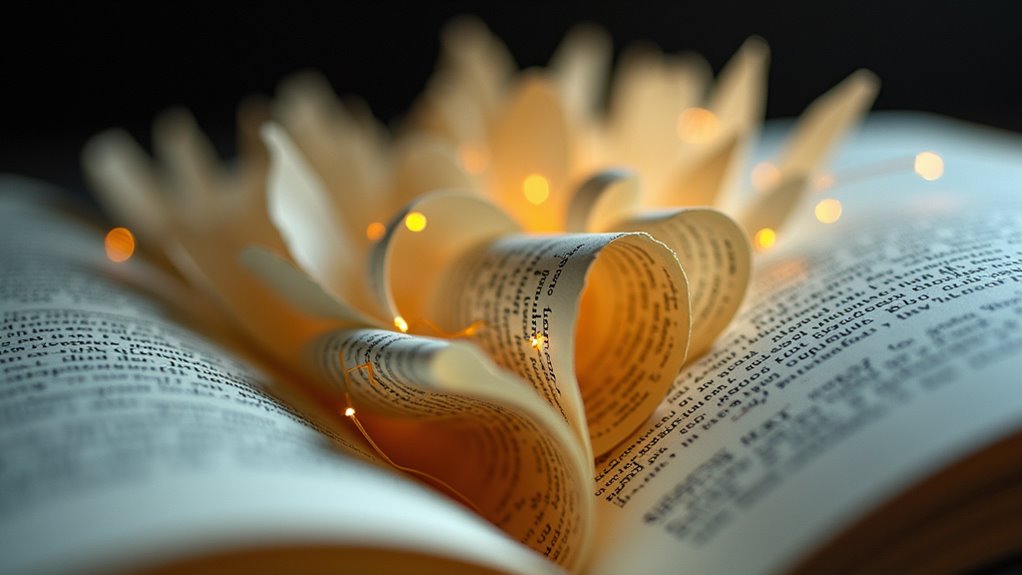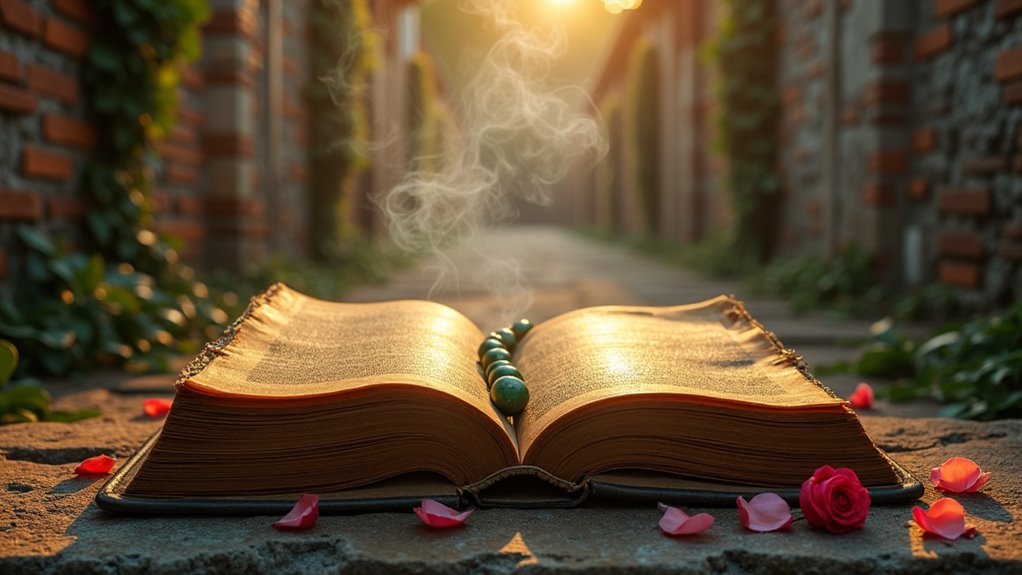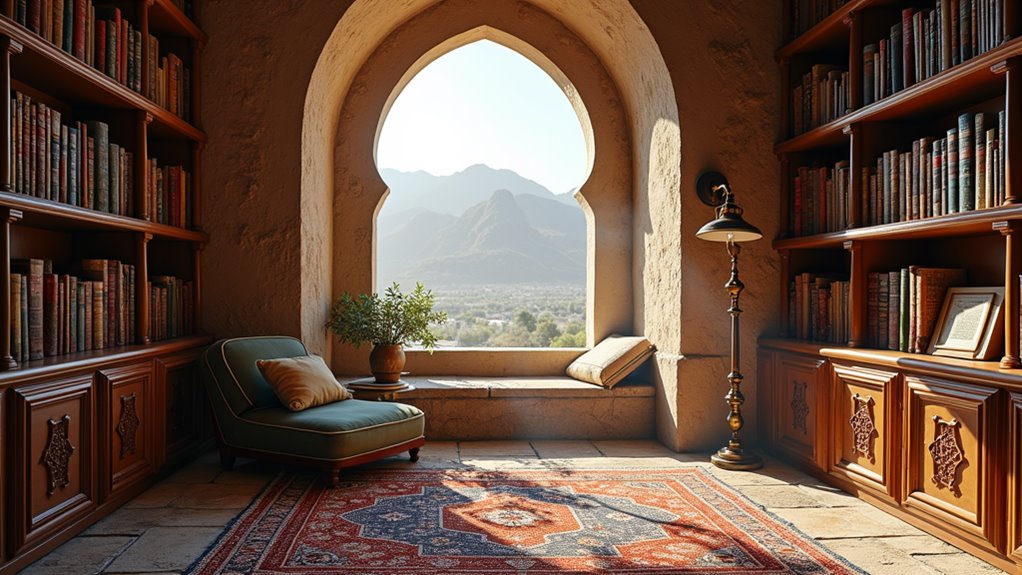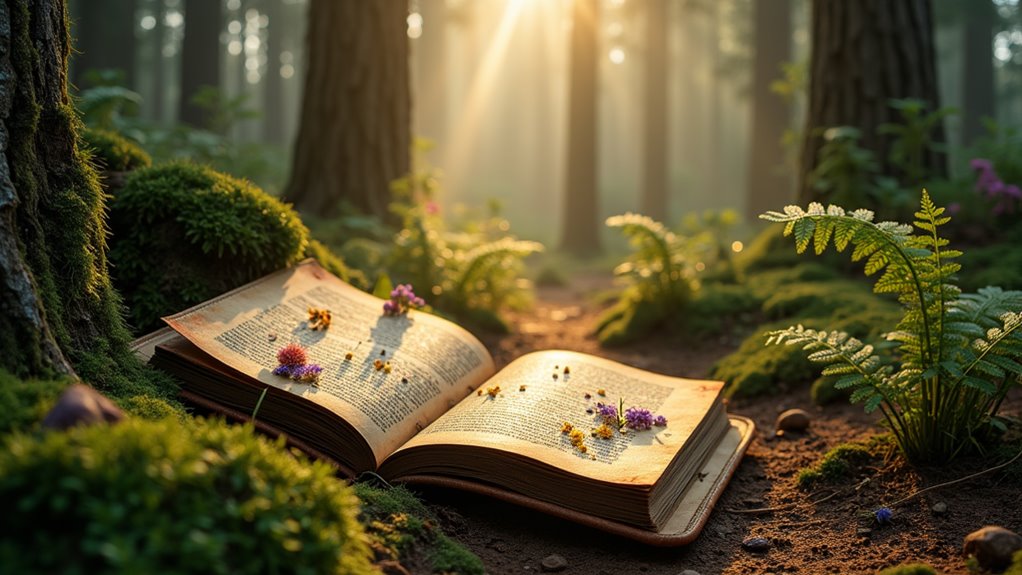You'll find a world beyond mainstream literature's familiar territories where untranslated masterpieces and forgotten voices await discovery. From the Arctic's Inuit storytellers to the Amazon's indigenous narratives, these hidden literary landscapes offer fresh perspectives on survival, tradition, and human connection. Through experimental forms and digital innovations, writers challenge conventional storytelling while translations bridge cultural divides, revealing universal truths in unique ways. Sacred spaces emerge through evocative settings, where ancient wisdom meets contemporary insight. This vast literary terrain holds countless pathways to unexplored realms of human experience and imagination.
Key Takeaways
- Remote and indigenous narratives offer fresh perspectives on survival and tradition through unique storytelling from Arctic, Pacific, and Amazon cultures.
- Translation enables access to diverse literary works across cultures, revealing unique perspectives and enriching global storytelling traditions.
- Experimental literary forms break traditional narrative structures through digital integration, typography, and interactive storytelling techniques.
- Forgotten voices and archived manuscripts challenge conventional narratives and reveal silenced perspectives throughout literary history.
- Sacred spaces in literature create universal connections through evocative settings that transcend geographical and cultural boundaries.
Hidden Gems in Translation

How often do readers miss out on extraordinary literary masterpieces simply because they're written in unfamiliar languages?
You'll find countless treasures waiting to be discovered through the art of translation, from Japanese magical realism to Persian poetry that captures the soul's deepest longings.
You don't need to speak the original language to appreciate these works. Thanks to skilled translators who bridge linguistic gaps, you can explore Yu Hua's raw emotional narratives from China, delve into Roberto Bolaño's surreal Chilean landscapes, or immerse yourself in Olga Tokarczuk's philosophical Polish fiction.
Each translation opens a window into unique cultural perspectives and storytelling traditions. By venturing beyond English-language literature, you'll unlock narratives that challenge your worldview and enrich your reading experience.
Stories From Remote Corners
While mainstream literature often spotlights urban stories, some of the most compelling narratives emerge from Earth's far-flung places.
You'll discover tales from the Arctic tundra, where Inuit writers weave stories of survival and tradition, or encounter narratives from remote Pacific islands that explore connections between people and ocean.
In Mongolia's vast steppes, you'll find works that capture nomadic life and ancient wisdom, while deep in the Amazon, indigenous voices share perspectives on nature and community that challenge Western worldviews.
These remote stories aren't just about geographical distance – they're windows into unique ways of seeing and understanding life.
Through them, you'll explore human experiences that remain hidden from the world's literary capitals, offering fresh insights into our shared humanity.
Experimental Forms Breaking Boundaries

What happens when literature breaks free from traditional forms? You'll find yourself immersed in a world where pages become playgrounds and words transform into visual art.
Authors experiment with typography, page layout, and digital integration to create multi-sensory experiences that challenge how you perceive storytelling.
You'll discover novels told through social media posts, stories that read backward and forward, and narratives that branch like choose-your-own-adventure games but for adults.
These experimental works push against conventional boundaries, using techniques like stream of consciousness, fragmented narratives, and hybrid genres.
Digital literature adds another dimension, incorporating hypertext, animation, and interactive elements that respond to your choices.
The result is a dynamic literary landscape where form and content merge to create entirely new reading experiences.
Rediscovering Lost Literary Voices
Beyond the frontiers of experimental forms lies a rich treasury of forgotten voices waiting to be heard again.
You'll discover writers who disappeared into history's shadows, their works buried by time, politics, or circumstance. These lost voices often challenge conventional narratives and offer unique perspectives on their eras.
As you dig deeper into archived manuscripts and out-of-print collections, you'll uncover authors who were silenced by oppression or overlooked due to their gender, race, or social status.
From recovered medieval women poets to rediscovered Harlem Renaissance writers, these voices reshape our understanding of literary history.
They're not just historical curiosities – they're vital links in literature's ongoing conversation, offering fresh insights that resonate with contemporary readers and writers alike.
Sacred Places Within Pages

How often do books transport you to hallowed spaces within their pages? Whether it's a medieval cathedral bathed in stained-glass light or a quiet grove where ancient wisdom whispers through leaves, literature creates sanctuaries within our minds.
You'll find these sacred spaces aren't limited to religious texts. They emerge in novels where characters seek solace in mountain retreats, in poems that transform ordinary rooms into temples of contemplation, and in memoirs where childhood homes become shrines to memory.
Through carefully chosen words, authors craft these reverent locations that resonate with your own quest for meaning.
Within these literary sanctuaries, you'll discover universal truths that transcend time and culture, reminding you that sacred places exist not just in physical locations, but in the transformative power of words themselves.
Literary Maps Rarely Traveled
You'll find a world beyond bestseller lists in the untranslated works of international authors and the dusty manuscripts of regional storytellers.
While mainstream literature flows through familiar channels, these lesser-known works hold intimate portraits of local life and cultural perspectives you won't encounter in popular fiction.
Within their pages lie stories-within-stories that reveal hidden narratives, passed down through generations but rarely reaching wider audiences.
Hidden Voices From Abroad
While mainstream literature often spotlights Western classics, countless masterpieces from lesser-known regions remain hidden in plain sight.
You'll find gems like Indonesian author Pramoedya Ananta Toer's "This Earth of Mankind" or Lebanese writer Hanan al-Shaykh's "The Story of Zahra" waiting to be discovered.
When you venture into these unexplored literary territories, you'll encounter unique perspectives that challenge your worldview.
African writers like Ngugi wa Thiong'o illuminate colonial experiences through indigenous languages, while Central Asian poets like Chingiz Aitmatov blend folklore with modern narratives.
These voices offer intimate glimpses into cultures that rarely make headlines in Western media.
Forgotten Regional Writing Gems
Beyond the international literary landscape lie hidden treasures in regional writing that often go unnoticed.
You'll find remarkable stories nestled in small presses, local anthologies, and regional collections that capture the essence of specific places and cultures.
These overlooked gems offer intimate portraits of communities, dialects, and traditions that mainstream publishing typically misses.
You might discover a powerful Appalachian novelist chronicling coal town life, or a Gulf Coast poet capturing the rhythm of coastal communities.
Regional writers often bring authenticity and deep cultural understanding to their work.
Untold Stories Within Stories
Inside great literature lies a network of hidden narratives that readers often miss at first glance.
You'll find these untold stories woven between main plot lines, tucked into seemingly minor character interactions, or buried within symbolic references.
When you explore deeper, you'll discover entire worlds within a casual conversation between secondary characters, or uncover parallel narratives that mirror the primary story.
Think of Virginia Woolf's Mrs. Dalloway, where a passing stranger's thoughts create an entirely separate storyline, or Borges' Garden of Forking Paths, where multiple realities exist simultaneously.
These literary Easter eggs reward careful readers with fresh perspectives and deeper meanings.
As you reread familiar works, you'll notice how authors craft these nested narratives to enrich their stories' emotional and intellectual impact.
Cultural Crossroads and Connections

Throughout history, literature has served as a powerful bridge between diverse cultures, creating intricate networks of shared stories and ideas across continents.
When you explore these cultural intersections, you'll discover how ancient trade routes carried not just goods, but tales that shaped civilizations.
You'll find that Shakespeare drew inspiration from Italian novellas, while Japanese haiku influenced Western modernist poetry.
These cross-cultural exchanges continue today as you encounter stories that blend traditional folklore with contemporary themes.
Whether it's Magic Realism from Latin America influencing European fiction or African oral traditions enriching American literature, you're witnessing a constant dialogue between literary traditions.
These connections remind you that despite geographical boundaries, human experiences and emotions remain universally relatable through the written word.
Frequently Asked Questions
How Do Authors Decide Which Remote Locations to Feature in Their Stories?
Authors choose remote locations based on what you'd find compelling in a story.
They'll pick places that create the right mood, challenge their characters, or reflect themes they want to explore.
You'll notice they often select settings they've personally visited or thoroughly researched, ensuring authentic details.
Sometimes they'll choose locations that contrast with familiar environments to highlight cultural differences or create dramatic tension.
What Role Does Technology Play in Preserving Endangered Literary Traditions?
Like a digital time capsule, technology's been revolutionizing how you preserve endangered literary traditions.
You'll find digital archives capturing oral stories, apps teaching indigenous languages, and online platforms sharing rare manuscripts.
Through social media, you're connecting storytellers with global audiences, while translation software helps preserve narratives across languages.
Machine learning even assists in documenting disappearing dialects and cultural expressions for future generations.
Can Literary Landscapes Influence Real-World Tourism and Cultural Preservation?
Literary landscapes absolutely shape tourism and cultural preservation.
When you visit Prince Edward Island because of "Anne of Green Gables" or explore Tolkien's Oxford, you're participating in literary tourism.
These pilgrimages boost local economies and motivate communities to preserve historic sites.
You'll find that famous literary settings often lead to museums, guided tours, and cultural centers that protect and celebrate both the literature and local heritage.
How Do Weather Patterns and Seasons Affect Regional Storytelling Styles?
You'll find that weather and seasons deeply shape how stories are told across regions.
In cold climates, you'll notice longer, more detailed narratives that reflect indoor storytelling traditions during harsh winters.
Desert cultures often feature shorter, rhythmic tales told during cooler evenings.
Monsoon regions weave rain and cycles of renewal into their narratives, while tropical storytellers frequently incorporate nature's constant abundance and daily weather patterns.
Why Do Some Literary Movements Remain Confined to Specific Geographical Areas?
You'll find literary movements often stay regional because they're deeply rooted in local cultural identity, language, and shared experiences.
They reflect specific social conditions, political climates, and historical events that shaped that area.
When you examine movements like Southern Gothic or Nordic Noir, you'll see how they depend on unique geographical features, local traditions, and distinct societal values that don't easily translate to other regions.
Conclusion
You've journeyed through a million untold stories and ventured far beyond familiar literary territories. By exploring translated works, experimental forms, and forgotten voices, you've discovered how literature transcends borders and time. Now you're equipped to map your own path through these lesser-known landscapes, where every page turn reveals new cultural connections. The literary road less traveled awaits your next adventure.

Leave a Reply